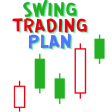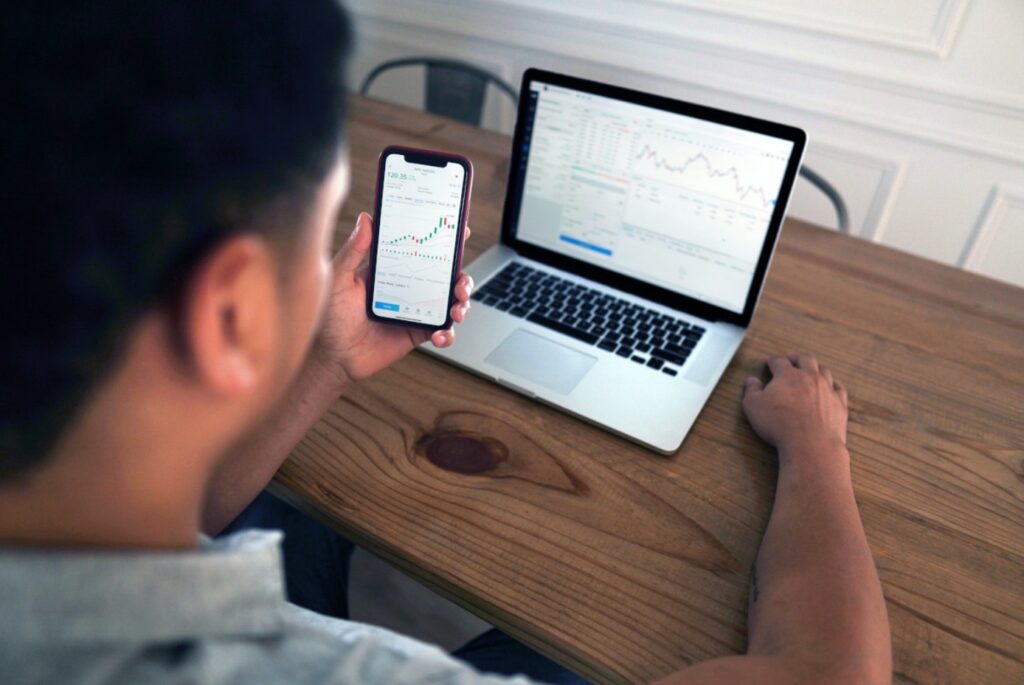Table of Contents
Introduction
Swing trading is a popular trading approach that can be beneficial for new traders. Because the time periods involved are modest, it is a relatively convenient approach to convey market thoughts. Swing traders are active in various financial markets, including forex, equities, and cryptocurrencies. But is swing trading the right method for you? Should you begin day trading or swing trading?
In this post, we’ll go over all you need to know about swing trading bitcoin and help you decide if it’s the best option for you.

What Is Swing Trading?
Swing trading is a trading method that aims to catch market movements that occur over a short to medium time frame. Swing trading seeks to capitalize on market “swings” that last from a few days to many weeks.
Swing trading tactics perform well in trending markets. If there is a strong trend over a longer time period, swing trading chances can be frequent, allowing swing traders to profit from larger price swings. In comparison, swing trading may be more challenging in a consolidating market. After all, when the market is moving sideways, it is more difficult to record substantial price fluctuations.
How Do Swing Traders Make Money?
As previously stated, swing traders seek to capture market movements that last from a few days to several weeks. As a result, swing traders will hold positions for longer than day traders but shorter than buy and hold investors.
Swing traders generally employ technical analysis to produce trade ideas, though not to the same level that day traders do. Swing traders may incorporate fundamental analysis into their trading strategy because fundamental developments can take weeks to unfold.
Nonetheless, price movement, candlestick chart patterns, support and resistance levels, and technical indicators are widely used to find trade opportunities. Swing traders frequently utilize indicators such as moving averages, the Relative Strength Index (RSI), Bollinger Bands, and the Fibonacci retracement tool.
Swing traders usually look at medium to high time frame charts. Why? A strong upswing or downturn must be confirmed over a longer time span. However, they may also look at intraday time frames, such as the 1-hour, 4-hour, and 12-hour charts, to identify specific entry and exit moments. These triggers can include a breakout or a pullback on a shorter time scale, for example.
However, the daily chart is probably the most relevant time frame for swing trading. Even so, trading and investment techniques might vary greatly amongst traders. It is important to note that what we have described here are not strict laws, but rather frequent situations.
Advantages & Disadvantages of Swing Trading
| Advantages of Swing Trading | Disadvantages of Swing Trading |
|---|---|
| 1. Potential for Higher Gains: Allows capturing substantial price movements within a defined range, leading to significant profits. | 1. Requires Patience: Trades may take days or weeks to materialize, which is not ideal for those seeking rapid returns. |
| 2. Reduced Time Commitment: Doesn’t demand constant monitoring, suitable for traders with other commitments. | 2. Market Volatility Risk: Sudden market fluctuations can result in unexpected losses. |
| 3. Emphasizes Risk Management: Clear entry and exit points improve risk assessment and management. | 3. Missed Opportunities: Waiting for optimal entry points can result in missed lucrative trades. |
| 4. Opportunity for Diverse Strategies: Allows combining various indicators and strategies for informed decisions. | 4. Psychological Challenges: Requires discipline to stick to the trading plan and resist emotional impulses. |
| 5. Suitable for Beginners: A less daunting option for newcomers to enter the crypto trading realm due to its manageable pace. | 5. Potential for Drawdowns: Extended periods of sideways movement can limit profit potential. |
| 6. Flexibility in Market Conditions: Can be applied to different market trends, both bullish and bearish. | 6. Inaccurate Predictions: Even with analysis, market moves can be unpredictable, affecting trade outcomes. |
| 7. Customizable Timeframes: Trading opportunities are available on various timeframes, accommodating diverse strategies. | 7. Transaction Costs: Frequent trades may accumulate higher transaction fees, impacting overall profitability. |
By balancing these benefits and drawbacks, traders may make informed decisions and implement methods that are consistent with their risk tolerance and trading objectives in the turbulent world of swing trading cryptocurrency.
Swing Trading vs Day Trading in Crypto
| Swing Trading | Day Trading |
|---|---|
| 1. Time Horizon: Usually holds positions for days to weeks, capitalizing on medium-term price movements. | 1. Time Horizon: Involves opening and closing positions within the same trading day, profiting from short-term price movements. |
| 2. Trading Frequency: Less frequent trading, reducing the need for constant monitoring. | 2. Trading Frequency: High frequency demands constant attention and quick decision-making throughout the trading day. |
| 3. Flexibility: Allows traders to participate in various activities beyond trading due to less time commitment. | 3. Intensive Time Commitment: Requires full-time focus, limiting involvement in other activities. |
| 4. Psychological Stress: Less intense and stressful as trades unfold over a more extended period. | 4. Psychological Stress: Highly stressful due to the need for quick decision-making and frequent actions. |
| 5. Risk Management: Affords better risk assessment and management with longer holding periods. | 5. Risk Management: Requires swift risk assessment and immediate decision-making, which may lead to higher risks. |
| 6. Strategy Complexity: Often involves more complex strategies for analyzing broader market trends. | 6. Strategy Complexity: Focuses on short-term movements, utilizing simpler, immediate strategies. |
| 7. Profit Potential: Higher potential for substantial gains due to capturing larger price movements. | 7. Profit Potential: Limited gains per trade, but cumulative profits can be significant with numerous trades. |
| 8. Market Analysis: Focuses on broader market analysis and trends for informed decisions. | 8. Market Analysis: Concentrates on intraday market movements and immediate price action. |
| 9. Transaction Costs: Generally incurs lower transaction costs due to less frequent trades. | 9. Transaction Costs: Frequent trading results in higher cumulative transaction fees. |
Understanding the differences between swing trading and crypto day trading helps traders choose the best technique based on their preferences, availability, and risk tolerance in the cryptocurrency market.
Crypto Swing Trading Strategies
In the realm of cryptocurrency, using effective tactics is critical to success in swing trading. This section goes into a variety of tried-and-true ways aimed to improve your bitcoin swing trading skills, ensuring informed judgments and positive outcomes:
- Moving Averages Crossover: This approach analyzes the crossover of multiple moving averages to determine potential trend reversals or continuations. Traders commonly utilize 50-day and 200-day moving averages to identify entry and exit positions.
- Support and Resistance: Traders monitor past price levels for an asset’s support or resistance. Swing trading selections can be based on buying near support levels and selling near resistance.
- Breakout Trading: Breakout trading involves identifying price breakouts from established ranges or patterns, which indicate possible trend changes. Traders seek to capitalize on major price moves by entering positions as the price breaks out.
- Fibonacci Retracement: Traders use Fibonacci ratios to identify potential reversal or continuation levels following market movements. These retracement levels frequently serve as points of interest for entering or exiting trades.
- Bollinger Bands: This method relies on volatility metrics. Traders look for periods of low volatility (contraction) followed by projected high volatility (expansion) before entering positions.
- Trendline Analysis: Traders use trendlines on charts to determine the direction of the current trend. Common trading tactics include buying near an ascending trendline in an uptrend and selling near a descending trendline in a downturn.
Each approach has its own set of considerations, risk levels, and applicability to different market conditions. Traders frequently combine or adjust several techniques based on their tastes to create a tailored strategy to swing trading in the cryptocurrency market.
How do I Choose Coins for Swing Trading in Crypto
Swing trading in the cryptocurrency market necessitates a keen eye for prospective profits. Choosing the correct coins necessitates extensive market research. Here are the steps to aid your coin selecting process:
- Research Market Volatility: Identify coins with high historical price volatility for swing trading. High volatility increases the likelihood of price swings, creating excellent trading opportunities.
- Review Historical Performance: Analyze a coin’s historical price data to assess its performance under various market conditions. Look for patterns that indicate future swings.
- Fundamental Analysis: Evaluate the coin’s purpose, technology, team, and community support. Strong fundamentals are frequently associated with more steady price changes.
- Technical Analysis: Technical indicators such as Moving Averages, Relative Strength Index (RSI), and Bollinger Bands can help pinpoint entry and exit positions. These tools assist in determining price trends for a cryptocurrency.
- Market Capitalization and Liquidity: Consider coins with substantial market capitalization and sufficient trading volume. Higher liquidity allows for simpler entry and exit from trades without severe price slippage.
- News and Market Sentiment: Monitor news and social media for updates and sentiment on individual coins. Positive news and attitude can influence price changes.
- Diversification: To spread risk, consider diversifying your portfolio with multiple coins. To mitigate volatility, balance high-risk, high-reward coins with more reliable options.
- Stay Updated: Maintain an up-to-date coin selection strategy by monitoring market circumstances, news, and trends.
How to Determine If a Swing Trading Strategy Is Effective
Several elements go into determining the efficiency of a swing trading strategy, including:
- Consistent Profitability: Evaluate the strategy’s success by examining consistent profits over a specific time period. Calculate the win-loss ratio and overall profitability.
- Risk Management: Examine risk-reward ratios to ensure that losses are minimized. A successful approach reduces losses while maximizing gains.
- Adherence to Plan: Determine whether your transactions are consistent with your predefined strategy. Deviations might affect overall performance.
- Market situations: Evaluate your strategy’s success in various market situations, such as bullish, bearish, and range markets.
- Adjustments and Optimization: A successful strategy emerges. Regularly analyze and optimize your strategy depending on market input and results.
What is the Best Time to Swing Trade?
The optimal period for swing trading is generally centered on market volatility and liquidity:
- Volatility: During moments of high volatility, there are greater opportunities for swing trading due to larger price changes.
- Liquidity: Prefer bigger trading volumes for smoother execution and lower price slippage.
- Timeframes: Identify ideal timeframes for your plan and assets. Some traders choose shorter timescales for more frequent trades, while others favor longer ones for more accuracy.
- Economic Calendar: Consider market occurrences, news releases, and economic reports that may impact volatility. Plan your trades around these occurrences for better results.
- Overlap of Sessions: Overlapping sessions, such as the opening hours of major markets like New York and London, can lead to heightened volatility and liquidity, making them ideal for swing trading.
Understanding the optimal conditions and comparing your strategy’s performance to these variables can assist you in determining the success of your swing trading strategy and the best times to trade.
Conclusion
Swing trading in the cryptocurrency market enables traders to profit on short- to medium-term price changes. This strategy, which is focused on price fluctuations, enables traders to grab gains within specific timeframes.
Understanding the complexities of swing trading, including techniques, risk management, and variations from day trading, is critical for newbies entering the volatile world of cryptocurrency trading. It focuses on adaptation, risk mitigation, and continual plan improvement.
As you start swing trading cryptocurrency, keep in mind that disciplined execution, detailed analysis, and staying on top of market changes are typically key to success. To handle the ever-changing crypto market, you must constantly modify your techniques, manage risks intelligently, and have a learning attitude.
Finding the right balance of technical analysis, risk management, and market timing is essential for mastering swing trading and attaining consistent success in cryptocurrency markets.
FAQs on Crypto Swing Trading
1. What is Crypto Swing Trading?
Crypto swing trading is a strategy aimed at capturing short-to-medium-term price movements within a specific trading range. This approach relies on identifying price swings that occur over days or weeks, profiting from these oscillations rather than focusing on long-term trends.
2. How does Swing Trading work in the Crypto Market?
Swing trading involves analyzing historical price movements, chart patterns, and technical indicators to determine entry and exit points. Traders aim to buy at the lower end of a range and sell at the higher end, capitalizing on predictable swings in prices.
3. What are the Advantages of Swing Trading in Crypto?
- Potential for Higher Gains: Captures substantial price movements within a defined range.
- Reduced Time Commitment: Requires less constant monitoring, suitable for traders with other commitments.
- Risk Management: Clear entry and exit points improve risk assessment and management.
- Opportunity for Diverse Strategies: Allows combining various indicators and strategies.
- Suitable for Beginners: Less daunting due to its manageable pace.
- Flexibility in Market Conditions: Can be applied to different market trends.
- Customizable Timeframes: Trading opportunities are available on various timeframes.
4. What are the Disadvantages of Swing Trading in Crypto?
- Requires Patience: Trades may take days or weeks to materialize.
- Market Volatility Risk: Sudden fluctuations can result in unexpected losses.
- Missed Opportunities: Waiting for optimal entry points can result in missed trades.
- Psychological Challenges: Requires discipline to stick to the trading plan.
- Potential for Drawdowns: Extended periods of sideways movement can limit profit potential.
- Inaccurate Predictions: Market moves can be unpredictable, affecting outcomes.
- Transaction Costs: Frequent trades may accumulate higher fees.
5. How does Swing Trading differ from Day Trading?
- Time Horizon: Swing trading holds positions for days to weeks, while day trading involves opening and closing positions within the same day.
- Trading Frequency: Swing trading is less frequent, whereas day trading demands constant attention.
- Flexibility: Swing trading allows participation in other activities, unlike day trading which requires full-time focus.
- Psychological Stress: Swing trading is less intense compared to the high stress of day trading.
- Risk Management: Swing trading allows better risk assessment with longer holding periods.
- Strategy Complexity: Swing trading involves complex strategies for broader market trends, while day trading focuses on short-term movements.
- Profit Potential: Swing trading has higher potential for substantial gains, while day trading profits from numerous smaller trades.
6. What are some popular Swing Trading Strategies in Crypto?
- Moving Averages Crossover: Analyzing the crossover of different moving averages to identify potential trend reversals or continuations.
- Support and Resistance: Buying near support and selling near resistance levels.
- Breakout Trading: Entering positions as the price breaks out from established ranges or patterns.
- Fibonacci Retracement: Using Fibonacci ratios to identify potential reversal or continuation levels.
- Bollinger Bands: Using volatility measures to identify periods of low and high volatility.
- Trendline Analysis: Drawing trendlines to identify the direction of the prevailing trend.
7. How do I Choose Coins for Swing Trading?
- Research Market Volatility: Identify coins with historical price volatility suitable for swing trading.
- Review Historical Performance: Analyze a coin’s past performance.
- Fundamental Analysis: Assess the coin’s purpose, technology, team, and community support.
- Technical Analysis: Use indicators like Moving Averages, RSI, and Bollinger Bands.
- Market Capitalization and Liquidity: Consider coins with higher market capitalization and adequate trading volumes.
- News and Market Sentiment: Monitor news and social media for developments.
- Diversification: Opt for a diverse portfolio to spread risk.
- Stay Updated: Continuously adapt your coin selection strategy based on market conditions.
8. How to Know If a Swing Trading Strategy Is Working?
- Consistent Profitability: Assess consistent profits over a defined period.
- Risk Management: Ensure losses are controlled with favorable risk-reward ratios.
- Adherence to Plan: Evaluate if your trades align with your predefined strategy.
- Market Conditions: Assess performance in different market conditions.
- Adjustments and Optimization: Regularly review and optimize your approach.
9. What is the Best Time to Swing Trade?
- Volatility: Look for periods of heightened volatility.
- Liquidity: Prefer times with higher trading volumes.
- Timeframes: Identify optimal timeframes based on your strategy.
- Economic Calendar: Plan trades around market events and news releases.
- Overlap of Sessions: Major market session overlaps, like the New York and London sessions, often offer increased volatility and liquidity.






